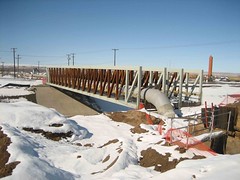When I was in Phoenix a couple of years ago, I made a pilgrimage to the Frank Lloyd Wrightish Biltmore. Phoenix is flat-out desert, hot, just 7.5 inches of rain (19 cm) a year. But the Biltmore is an oasis, green, cool and shady, the implication being that you can beat back the desert if you’ve got enough money. But here’s what I liked most about the Biltmore: its driveway is a bridge across a concrete Central Arizona Project river. In first world deserts, we build cities and abstract ourselves from the complex plumbing needed to bring them water. And in so doing, we abstract ourselves from the water itself. But at the Biltmore, as you drive into the shady oasis, you can’t ignore the plumbing needed to make it that way.
I’ve been thinking about this whole abstraction problem over the last week as Albuquerque lies under a blanket of snow. This is unusual for us, and it’s got us thinking about water in a much more direct way than usual. Usually, the snow that provides New Mexico’s water supplies falls in the northern mountains. To the extent we use it here in the Middle Rio Grande Valley, it’s used in irrigation ditches down in the valley. Albuquerque’s municipal water is currently supplied essentially entirely by pumping groundwater. But that is going to change in the next couple of years, as we start using San Juan River water. A massive plumbing project is underway around town to capture, treat and distribute the water, but once the construction-related traffic delays are over, that system too will be abstracted. But for a brief moment, as we lie under a blanket of snow, we have a chance to actually think a little bit about our water supply, experience it directly.
The wise member of my family, Lissa, asked me a great question yesterday as we were driving out and about amid the snow: what effect will this storm have on Elephant Butte? (Elephant Butte, for those not from here, is the state’s largest water storage reservoir.) After years of sub-par precipitation and aggressive water use in the state, the Butte is low. On Jan. 1, it had a little more than 500,000 acre feet of water in it, well below the Jan. 1 average of 1.2 million acre feet. So it’s about 700,000 acre feet low. So how much has the recent round of storms helped it? The short answer is not at all. The preliminary runoff forecasts show runoff past Otowi in north-central New Mexico – probably the best measuring point for Middle Rio Grande flow – essentially breaking even with the latest round of storms.
That’s an important fact, but it really doesn’t help us get past the abstraction and use the storm we’ve experienced to help us understand viscerally, rather than abstractly, what our experience can tell us. What I’m about to do is pretty squishy – I’d never put this in the newspaper without a lot more rigor from the snowpack-runoff community to be sure the numbers are solid. But it’s a reasonable first cut, and it should give you some idea of what these last storms mean.
Elephant Butte is 700,000 acre feet below average. That means we’d need 700,000 acre feet above normal for the next four months – the snowpack season – to bring it up to normal. The biggest of this latest round of storms was good enough to add about 100,000 feet to the runoff forecast. So to bring Elephant Butte up to normal, we’d need seven extra similar storms. Not just seven storms, but seven extra storms above and beyond what we normally get – essentially one extra big storm every too weeks.
This is a little bit misleading for folks living in Albuquerque, because while we’ve been buried under a historically large storm, not a whole lot fell up in the mountains. But since y’all now have a clear experience of what a big storm is like, you can now use that as a benchmark to think about what we need to bring our state’s water supply up to normal.

